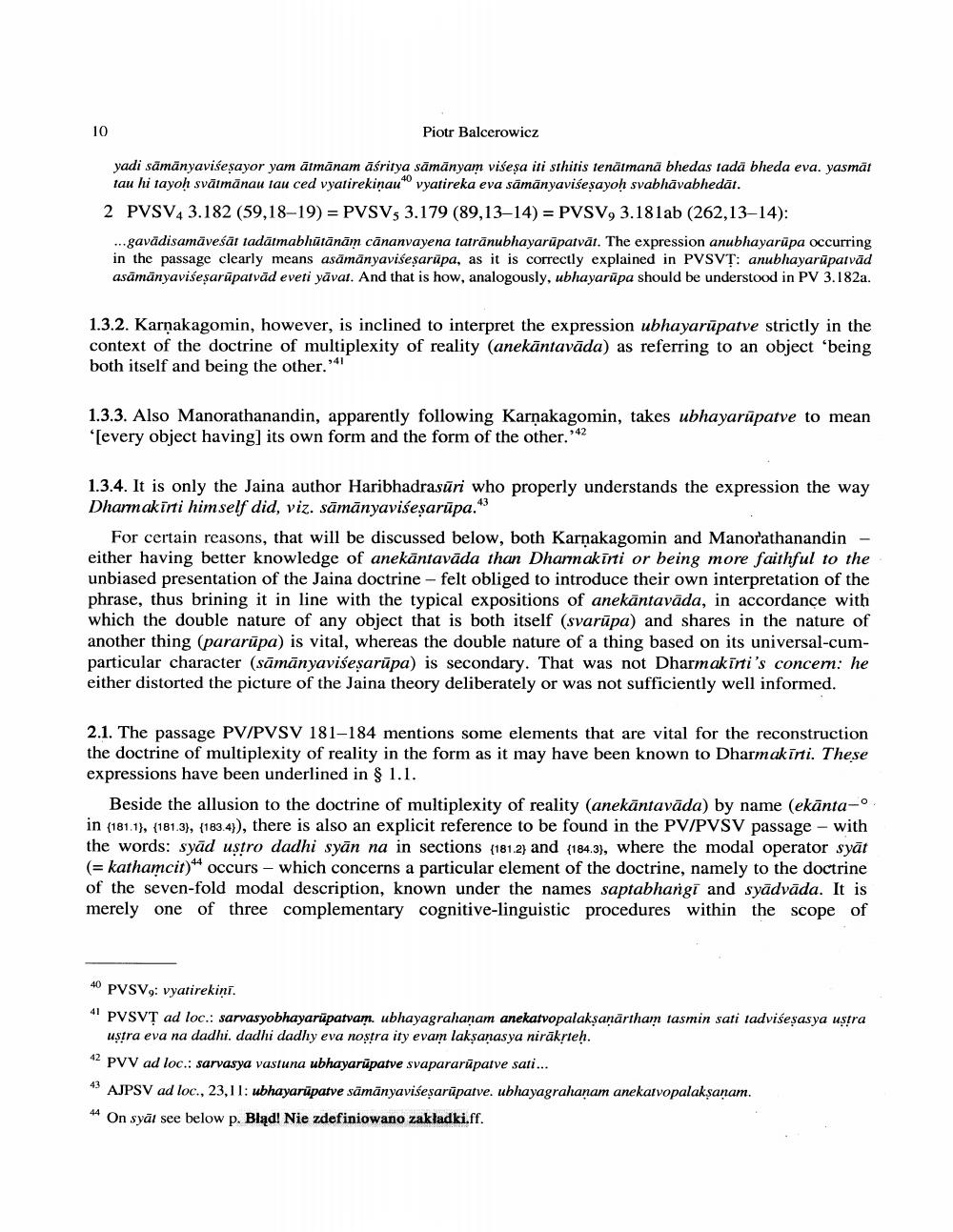________________
10
Piotr Balcerowicz
yadi sämänyavisesayor yam ātmānam āśritya sāmānyam višesa iti sthitis tenätmanā bhedas tada bheda eva. yasmāt
tau hi tayoh svātmānau tau ced vyatirekiņauo vyatireka eva sämänyaviseșayoh svabhāvabhedāt. 2 PVSV43.182 (59,18-19) = PVSV, 3.179 (89,13–14) = PVSV, 3.181ab (262,13–14): ...gavādisamāveśāt tadātmabhūtānām cānanvayena tatrānubhayarūpatvāt. The expression anubhayarūpa occurring in the passage clearly means asāmānyaviseșarūpa, as it is correctly explained in PVSVT: anubhayarūpatvād asāmānyaviseşarūpatvād eveti yāvat. And that is how, analogously, ubhayarūpa should be understood in PV 3.182a.
1.3.2. Karņakagomin, however, is inclined to interpret the expression ubhayarūpatve strictly in the context of the doctrine of multiplexity of reality (anekāntavāda) as referring to an object being both itself and being the other.''
1.3.3. Also Manorathanandin, apparently following Karņakagomin, takes ubhayarūpatve to mean '[every object having] its own form and the form of the other.42
1.3.4. It is only the Jaina author Haribhadrasūri who properly understands the expression the way Dharmakirti himself did, viz. sāmānyaviseșarüpa."
For certain reasons, that will be discussed below, both Karņakagomin and Manorathanandin - either having better knowledge of anekāntavāda than Dharm akinti or being more faithful to the unbiased presentation of the Jaina doctrine - felt obliged to introduce their own interpretation of the phrase, thus brining it in line with the typical expositions of anekāntavāda, in accordance with which the double nature of any object that is both itself (svarūpa) and shares in the nature of another thing (pararūpa) is vital, whereas the double nature of a thing based on its universal-cumparticular character (sāmānyavisesarūpa) is secondary. That was not Dharmakirti's concem: he either distorted the picture of the Jaina theory deliberately or was not sufficiently well informed.
2.1. The passage PV/PVSV 181-184 mentions some elements that are vital for the reconstruction the doctrine of multiplexity of reality in the form as it may have been known to Dharmakirti. These expressions have been underlined in § 1.1.
Beside the allusion to the doctrine of multiplexity of reality (anekāntavāda) by name (ekāntain (181.1}, {181.3), (183.4}), there is also an explicit reference to be found in the PV/PVSV passage - with the words: syād ustro dadhi syān na in sections (181.2) and (1843), where the modal operator syāt (= kathamcit) occurs – which concerns a particular element of the doctrine, namely to the doctrine of the seven-fold modal description, known under the names saptabhangi and syādvāda. It is merely one of three complementary cognitive-linguistic procedures within the scope of
40 PVSV,: vyatirekini. 4. PVSVT ad loc.: sarvasyobhayarüpatvam. ubhayagrahanam anekatvopalaksanārtham tasmin sati tadviseşasya ustra
ustra eva na dadhi. dadhi dadly eva nostra ity evam laksanasya niräkrteh. 12 PVV ad loc.: sarvasya vastuna ubhayarüpatve svapararüpatve sati... 4. AJPSV ad loc., 23,11: ubhayarüpatve sämänyaviseşarūpatve. ubhayagrahanam anekalvopalaksanam. 44 On syāl see below p. Błąd! Nie zdefiniowano zakladki.ff.




